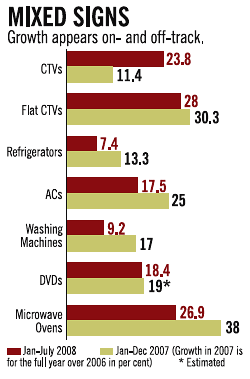R. Zutshi has many concerns. The least of them is an economic slowdown. “It’s happening in some sectors, but our focus is on managing costs more effectively in the face of rising input costs,” says the Deputy Managing Director of Samsung India. Also, earlier the industry had to deal with worries of a relatively cooler summer, and an early monsoon affecting its air conditioner business.
Zutshi’s optimism is backed by industrial production figures for July. Although industrial growth in the April-July period slowed to 5.7 per cent from 9.7 per cent in the corresponding period last year, consumer durables isn’t towing that falling line. In July the sector spurted by 11.2 per cent as against a contraction of 2.7 per cent last July.
For Samsung, growth and profitability go hand in hand. Costs are being managed by sustaining volume growth, which, in turn, is coming through thanks to increased productivity. Tact time (time between two TV sets rolling out of the assembly line) has been reduced at the Noida CTV plant from 4.9 seconds last year to 4.5 seconds.
Even as Zutshi steps up investments, he is obsessively keeping track of margins. “We are managing our margins by growing our business through sustained channel enhancement, a differentiated product line-up, innovative above-the-line and below-the-line marketing activities and at the same time managing production costs and better inventory management,” says Zutshi. One area where Samsung is in no mood to compromise is on marketing. Spends have so far been 4.5-5 per cent of turnover. Zutshi says that will be further hiked.
The Samsung way
• Launched up to 100 new product variants this year
• Set up 30 new branch offices across the country
• Optimising on specs of components in CTVs
• Getting its vendors to apply Six Sigma in their production processes
• Working to push sales volume by 30 per cent
Industry review
If growth in industrial production for July was higher than expected—7.1 per cent against consensus expectations of 6 per cent—it was thanks largely to the contribution of two sectors: capital goods (22 per cent), and consumer goods (7.3 per cent). Consumer goods, in turn, got a leg up primarily because of the pick-up in consumer durables, up smartly into double digits after falling in July 2007. Yet, that high figure might be misleading at least for one reason: as a Citi India report indicates, one component of consumer durables is two-wheelers.
In July, dispatches of the auto segment were up smartly, to 20 per cent (as against 9.4 per cent in June and a decline of 6.5 per cent last July). The upshot? Makers of white goods shouldn't necessarily be celebrating, as twowheelers would have played a big role in the July spike. The message: cost-cutting and value-engineering must continue, even as marketing spends are increased ahead of the festive season.
|

